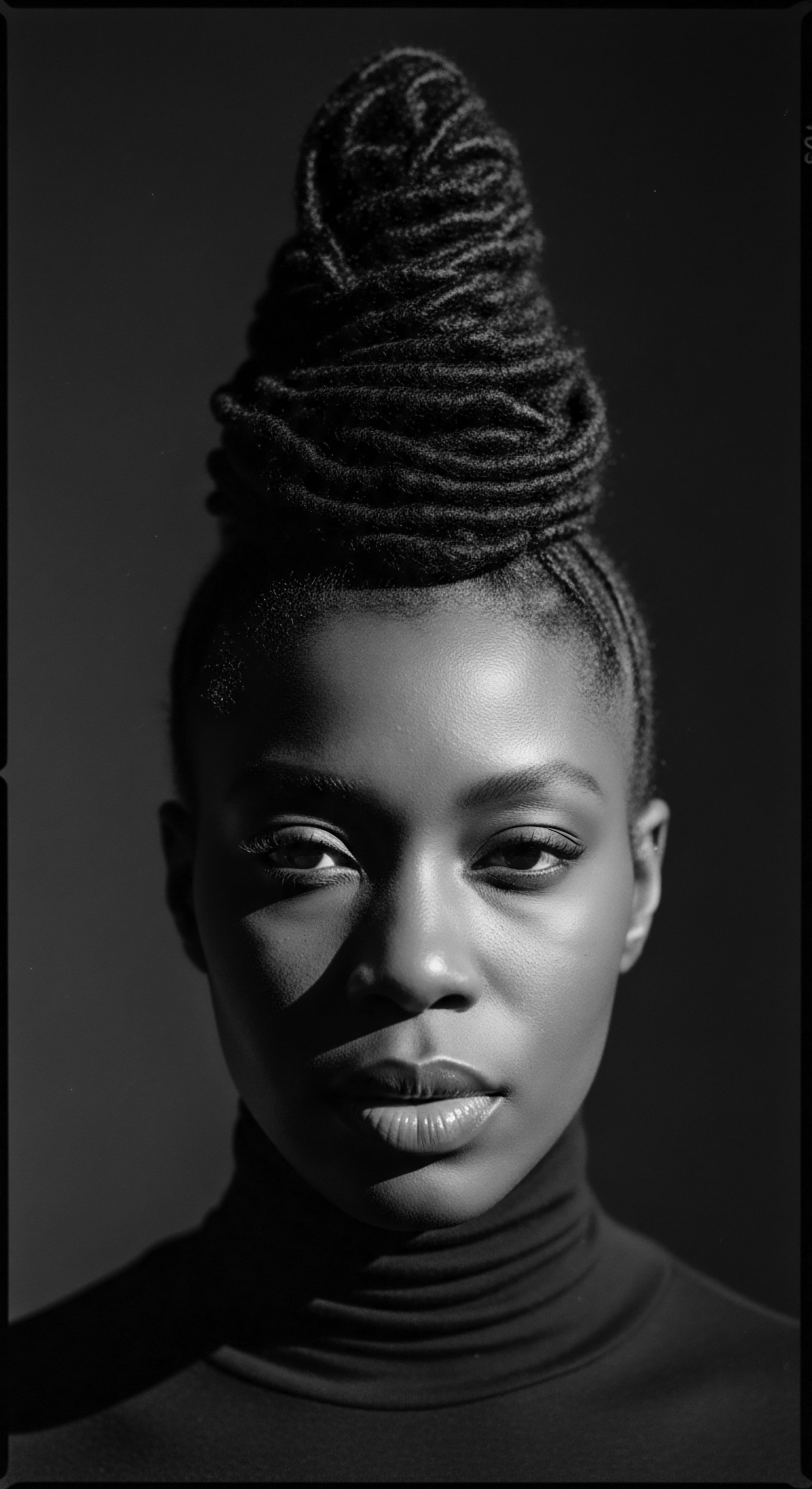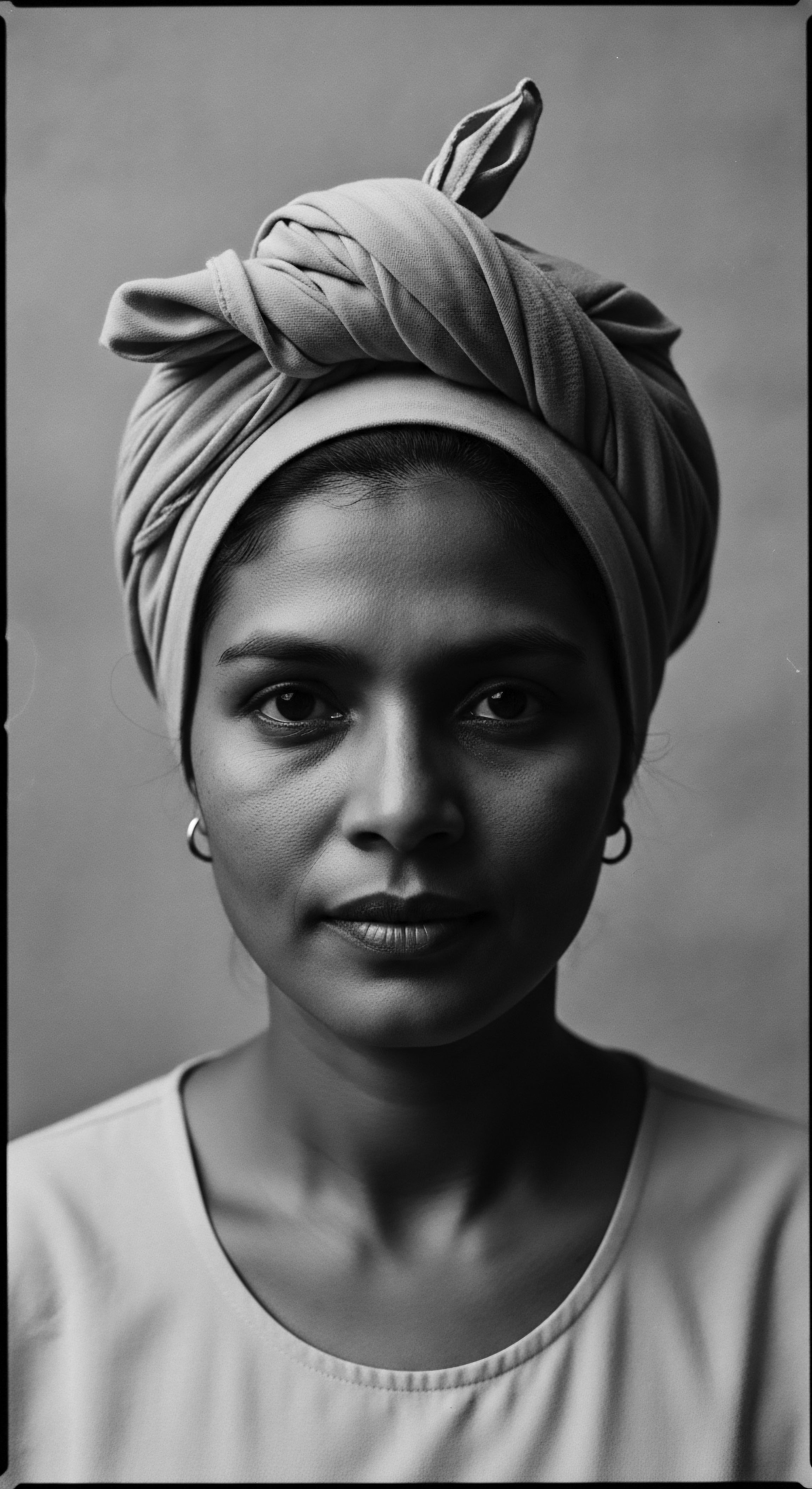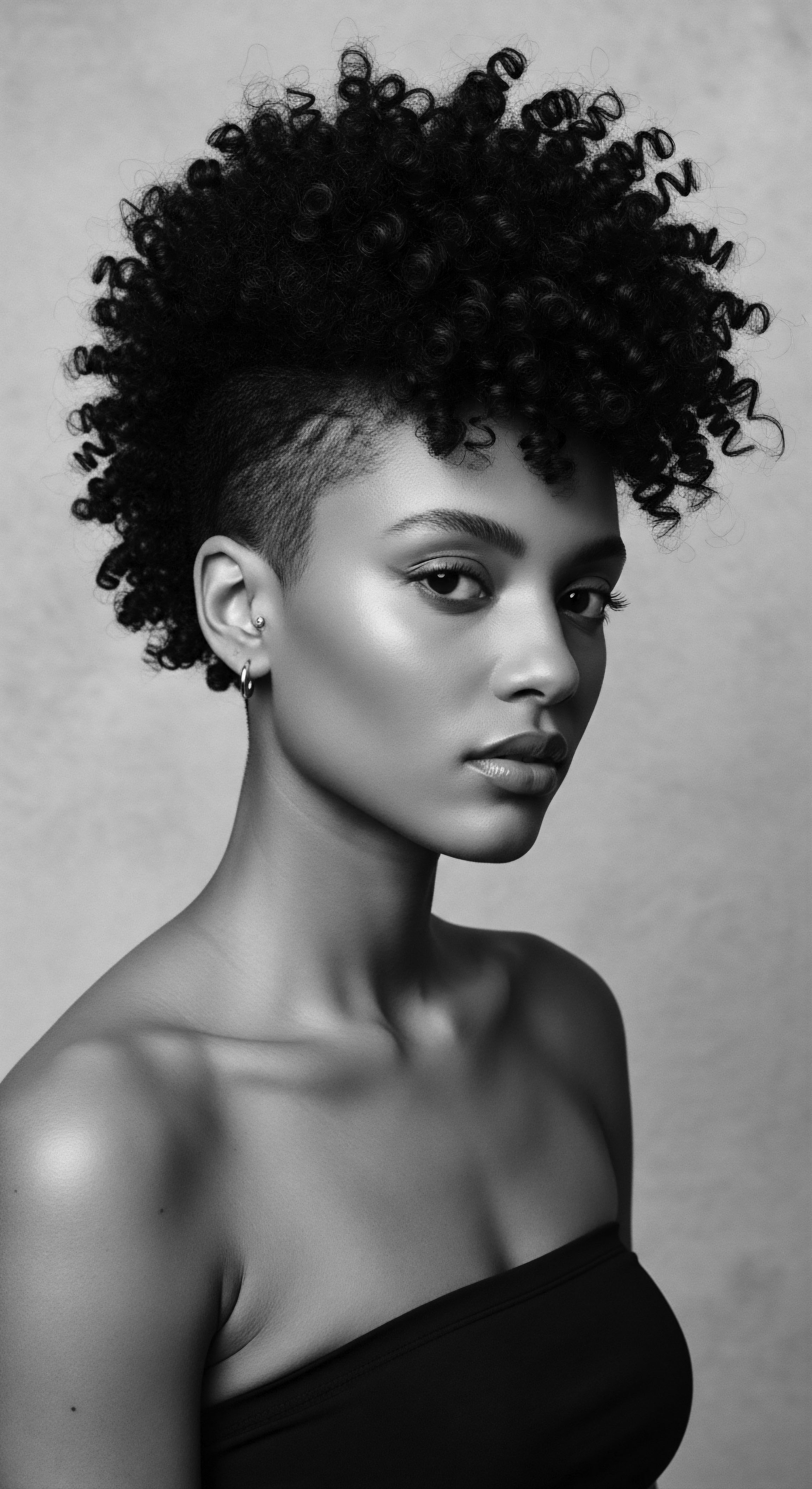
Fundamentals
The Hair Follicle, at its most elemental, stands as a profound testament to life’s enduring continuity, a delicate yet resilient structure deeply rooted within the dermis of our skin. It represents the very source from which each individual strand of hair emerges, shaping its unique character and defining its journey. For those embarking upon an exploration of textured hair, particularly within Black and mixed-race communities, understanding the hair follicle is not merely a scientific exercise; it is an act of acknowledging a lineage, a reverence for the foundational elements that have shaped identities across millennia. Its most fundamental meaning, stretching back to ancestral times, rests in its capacity to generate and anchor hair, a visible crown carrying stories of survival, artistry, and connection.
In ancient communities, where scientific instruments were unknown, the presence and behavior of hair spoke volumes. Observation of hair growth, its cyclical shedding, and its distinct textures provided early peoples with an intuitive grasp of this hidden root. They recognized hair as a living extension of the self, intrinsically linked to one’s vitality and spirit. This recognition transcended mere aesthetics, elevating hair to a conduit for spiritual connection and a marker of social identity.
Ancestral understandings of the hair follicle, though not articulated in modern biological terms, manifested in practices designed to honor and preserve this vital source. From carefully prepared herbal infusions to ceremonial scalp massages, these traditions reflected a deep, inherited wisdom about the importance of the hair’s origin point.
The early African peoples, particularly those across West and West Central Africa—including the Wolof, Mende, Mandingo, and Yoruba societies—integrated hair into the very fabric of their existence. Hair conveyed multiple meanings and held spiritual powers. Its careful cultivation was not simply about appearance; it was a reflection of health, status, and one’s place within the community. The unseen ‘root’ of the hair, the follicle, was intuitively understood as the wellspring of this visible manifestation of self and heritage.
The hair follicle serves as the hidden wellspring of each strand, embodying a profound connection to ancestral heritage and personal identity.

The Hair Follicle ❉ A Biological and Ancestral Anchor
At its core, the hair follicle is a tunnel-shaped structure, a tiny pocket within the epidermis that extends into the dermis. It is here, at the base of this structure, within the Hair Bulb, that the active process of hair creation commences. Within this bulb lies the Hair Matrix, a layer of rapidly dividing cells that continually produce new hair cells.
Surrounding the hair bulb is the Dermal Papilla, a small, cone-shaped structure composed of connective tissue, richly supplied with blood vessels and nerve endings. These blood vessels deliver the essential nutrients and hormones necessary for hair growth, making the dermal papilla a vital lifeline for the developing hair strand.
The hair shaft, the visible part of the hair above the skin’s surface, is composed primarily of a tough protein called Keratin, which is formed from these proliferating cells. As new cells are generated in the hair matrix, older cells are pushed upwards, away from the blood supply, undergoing a process of keratinization where they harden and die, forming the strong, protective hair shaft. This continuous cycle of growth, resting, and shedding is orchestrated within the hair follicle, ensuring a constant renewal of our hair.
Ancestral communities, lacking microscopes, nonetheless possessed an experiential knowledge of these processes. They observed the hair’s capacity for regeneration, its varying lengths, and its unique textures, all of which they understood as intrinsic qualities tied to the individual’s inner being and ancestral lineage. This intuitive understanding formed the bedrock of their hair care practices, which focused on nourishing the scalp and roots, recognizing that healthy hair began beneath the surface. The designation of hair as a crown, a symbol of dignity, or a marker of spiritual connection in many African cultures speaks to this profound appreciation for its inherent life force, originating from the unseen follicle.

Components and Their Earliest Interpretations
- Hair Bulb ❉ The expanded base of the hair follicle, where new hair cells are produced. Ancestrally, this would have been understood as the ‘root’ or ‘seed’ of the hair, the vital point from which growth sprung. Care rituals often centered on massaging the scalp, aiming to stimulate this area and promote robust hair.
- Dermal Papilla ❉ A small, cone-shaped projection of the dermis into the hair bulb, supplying nutrients. Though unseen, the health of the scalp, observed through hair vitality, would have been linked to this nourishing core. Traditional oils and botanical infusions were likely applied with the purpose of supporting this ‘feeding’ of the hair.
- Hair Matrix ❉ The active growth center within the hair bulb. The continuous, cyclical renewal of hair, observed across generations, would have hinted at a tireless inner engine, a perpetual spring of hair.
- Sebaceous Gland ❉ An oil-producing gland connected to the hair follicle, secreting sebum, a natural oil that lubricates the hair and scalp. This natural oil was recognized and utilized in ancestral practices. Many traditional African hair care regimens incorporated natural oils and butters, acknowledging sebum’s role in moisturizing and protecting textured hair, which tends to be drier due to its structure. The use of shea butter, palm oil, and various plant-derived oils across different African communities exemplifies this ancient understanding of hair’s need for external lipid support.
The Hair Follicle, in its elemental form, is a fundamental biological structure, yet its significance extends far beyond mere physiology when viewed through the lens of textured hair heritage. It stands as a living archive, holding the genetic blueprints that dictate the unique curl patterns, density, and strength of hair across Black and mixed-race populations. This intrinsic connection means that care for the hair follicle is not just about physical health; it is about honoring a genetic inheritance, a legacy of resilience, and a deep, ancestral connection to identity.

Intermediate
Moving beyond its basic designation, the hair follicle, for those with textured hair, holds an intermediate meaning that speaks to the enduring legacy of heritage practices. It is not merely a biological entity but a vessel through which ancestral knowledge of care, styling, and communal identity has been passed down and adapted through generations. This section clarifies the hair follicle’s significance by focusing on its practical applications within traditional and evolving hair care rituals, as well as the profound cultural and social implications of its unique morphology for Black and mixed-race hair across the diaspora.
The intrinsic characteristics of textured hair, directly determined by the shape and orientation of its follicles, profoundly shaped traditional care practices. Unlike straight hair, which typically emerges from a round follicle, textured hair grows from an oval or even flatter, more curved follicle. This curved follicular shape results in a hair shaft that bends and twists as it grows, leading to the characteristic coils, curls, and kinks. This structural difference also influences how natural oils, or sebum, travel down the hair shaft.
Sebum, produced by the sebaceous glands connected to the follicle, has a more challenging journey down a highly coiled strand, often leaving textured hair prone to dryness. This scientific reality validates the ancestral emphasis on moisturizing, oiling, and protective styling.
Consider the practices of communities across West Africa, where hair care was often a communal ritual, a time for bonding and the transmission of wisdom. The application of shea butter, coconut oil, and various plant-based infusions was not arbitrary; it was a response to the inherent needs of hair emerging from these distinct follicles. These traditions, passed down through oral histories and lived experience, represent an ancient, intuitive understanding of hair biology, long before modern trichology provided scientific explanations.
The unique curvature of the hair follicle in textured hair directly informs centuries of ancestral practices focused on moisture retention and protective styling.

Heritage Practices and Follicle Morphology
The unique morphology of the textured hair follicle has been a silent architect of hair care traditions for centuries. The elliptical or curved shape of the follicle, which causes the hair to grow in a helical or coiled pattern, means that the outer cuticle layers of textured hair strands are often raised, making them more susceptible to moisture loss and environmental damage. This biological reality underpins the ancestral emphasis on gentle handling, deep conditioning, and protective styles that minimize manipulation and exposure.
Traditional practices, from the meticulously crafted Cornrows of West Africa to the nourishing oil treatments of the Himba people, demonstrate a profound, inherited knowledge of how to tend to hair emerging from these specific follicles. These practices aimed to seal in moisture, protect delicate strands from breakage, and maintain the integrity of the hair structure. The act of braiding or twisting, for instance, reduces tangling and friction, which can otherwise disrupt the cuticle and lead to damage for coiled hair.
The continuity of these practices, even after the forced migration of enslaved Africans to the Americas, stands as a testament to their efficacy and cultural significance. Despite the brutal attempts to strip away identity, hair became a powerful site of resistance and cultural preservation. Enslaved women, stripped of traditional tools and ingredients, adapted, using whatever was available—from bacon grease to kerosene—to moisturize and style their hair, often in secret, to maintain a connection to their heritage. The ingenuity and resilience demonstrated in these adaptations underscore the deep practical and spiritual meaning tied to the hair follicle and its output.

Adaptive Care and Cultural Preservation
The historical journey of textured hair care reveals a continuous process of adaptation, driven by both the inherent biological needs of the hair follicle and the socio-cultural landscapes in which Black and mixed-race communities found themselves. The forced transatlantic journey saw many enslaved Africans’ heads shaved, a deliberate act designed to dehumanize and sever ties to their identity and heritage. Yet, the memory of traditional practices persisted, passed down through whispers and shared rituals.
In colonial societies, laws like the Tignon Laws in 18th-century Louisiana mandated that free women of color cover their elaborate hairstyles, which were seen as too alluring and a challenge to racial hierarchies. Despite this oppressive decree, these women transformed the headwrap into a statement of elegance and defiance, using luxurious fabrics and creative wrapping techniques. This act, while outwardly conforming, secretly honored the hair beneath, a testament to the enduring spirit of cultural preservation. The hair follicle, though hidden, remained the anchor of this defiance.
- Oiling Rituals ❉ Ancestral communities across Africa understood the need to lubricate the hair shaft from the follicle outwards. Ingredients such as Shea Butter (from the African shea tree), Palm Oil, and various botanical infusions were regularly applied to hair and scalp, recognizing their emollient properties that compensated for the natural oil’s slower descent down coiled strands. These practices not only moisturized but also formed a protective barrier against environmental stressors.
- Protective Styling ❉ Styles like Cornrows, Braids, and Locs, originating from various African ethnic groups, served a dual purpose ❉ aesthetic expression and hair preservation. By gathering hair into organized patterns close to the scalp, these styles minimized tangling, breakage, and exposure to the elements, directly supporting the longevity of strands emerging from the follicle. These styles were often markers of age, marital status, or tribal affiliation.
- Communal Grooming ❉ The act of hair care was often a shared experience, strengthening social bonds and transmitting generational wisdom. Grandmothers, mothers, and aunties would share techniques, knowledge of herbs, and stories, ensuring that the care of the hair follicle and the resulting hair remained deeply embedded in the cultural fabric. This collective wisdom contributed to the long-term health and cultural significance of textured hair.
The hair follicle’s distinct morphology, which dictates the shape of textured hair, thus stands as a silent protagonist in the story of Black and mixed-race hair heritage. Its physical attributes have not only shaped centuries of traditional care practices but have also served as a catalyst for resilience, innovation, and cultural affirmation in the face of adversity. The knowledge of how to nurture this particular follicular structure, passed down through generations, forms a living archive of wisdom.

Academic
The Hair Follicle, within the advanced discourse of textured hair, Black hair, and mixed-race hair heritage, represents a complex biological micro-organ that functions as a dynamic interface between genetic inheritance, environmental influences, and profound socio-cultural meaning. Its definition extends beyond mere anatomy to encompass its role as a primary determinant of hair phenotype, a repository of ancestral genetic information, and a site of both historical oppression and enduring cultural resistance. From an expert perspective, understanding the hair follicle requires a multi-disciplinary lens, integrating trichology, genetics, anthropology, and sociology to fully grasp its significance in shaping identity and care paradigms within diasporic communities. This is not simply a structure that grows hair; it is a biological archive, a living testament to journeys and adaptations.
The intricate architecture of the textured hair follicle, often described as elliptical or even ribbon-like in cross-section, dictates the helical coiling of the hair shaft as it grows. This distinct morphology is attributed to variations in gene expression and protein distribution within the follicular bulb, leading to asymmetrical keratinization and disulfide bond formation. Specifically, genes like EDAR and Hr are known to influence follicle shape and, consequently, hair texture. The greater the asymmetry of the follicle, the tighter the curl pattern, creating a spectrum from loose waves to tightly coiled kinky hair.
This biological specificity has direct implications for hair health ❉ the tortuous path of coiled hair makes it challenging for naturally produced sebum to travel down the entire length of the strand, contributing to inherent dryness and increased susceptibility to breakage. Therefore, the scientific delineation of the hair follicle provides a robust foundation for understanding the historical necessity and efficacy of moisture-centric and low-manipulation care regimens prevalent in textured hair traditions.
The socio-political implications of this follicular diversity are substantial. Historically, Eurocentric beauty standards have pathologized textured hair, often deeming it “unprofessional” or “unruly,” directly leading to discrimination based on hair texture. This societal bias has compelled many individuals with textured hair to chemically alter their hair, often with damaging relaxers, to conform to dominant norms. The hair follicle, in this context, becomes a silent witness to these pressures, its natural output often suppressed or modified.
A study by Dove in the UK revealed that half of Black and mixed women with afro-textured hair have faced discrimination because of their hair. This statistic underscores the profound societal impact stemming from the perceived ‘otherness’ of hair produced by distinct follicular structures, making the hair follicle a site of both biological and social inquiry.

The Follicle as a Genetic and Epigenetic Archive
From an academic standpoint, the hair follicle functions as a profound genetic and epigenetic archive, holding clues to ancestral migrations, environmental adaptations, and the diverse expressions of human heritage. Genetic factors play a primary role in determining hair texture, with specific genes influencing follicle shape and keratin protein arrangements. Variations in these genes account for the broad spectrum of hair types observed globally, including the unique characteristics of textured hair. This genetic coding, inherited through generations, links individuals directly to their ancestral lineages, making the hair follicle a living marker of heritage.
Beyond static genetics, the hair follicle is also susceptible to epigenetic modifications, where environmental factors, lifestyle, and even chronic stress can influence gene expression without altering the underlying DNA sequence. While the core follicular shape remains largely constant, factors such as nutrition, hormonal changes, and inflammatory conditions can impact hair growth cycles and strand quality. This interplay suggests that the follicle’s health can reflect not only inherited predispositions but also the lived experiences and environmental exposures of an individual and, by extension, their community through time. The historical context of limited resources or harsh living conditions for enslaved populations, for example, could have had subtle, long-term impacts on hair health across generations, even if the underlying follicular structure remained.

Interplay of Biology, Culture, and Identity
The academic investigation of the hair follicle within the context of textured hair demands a nuanced understanding of its complex interplay with cultural practices and identity formation. The physical attributes of the follicle and the resulting hair have not only dictated traditional care methods but have also shaped societal perceptions and personal expressions of self. The significance of hair in African societies, long before colonial contact, was deeply ontological; it depicted leadership status, communicated marital status, age, and religious affiliation, and was considered a conduit to spiritual realms.
This cultural weight meant that attacks on hair, such as the forced shaving of heads during the transatlantic slave trade, were acts of profound dehumanization and cultural erasure. The hair follicle, the very source of this powerful symbol, was thus implicated in the brutal machinery of oppression.
The persistence of traditional hair care practices, even under duress, illustrates the resilience of ancestral knowledge. The historical instance of Cornrows being used as covert maps for escape during slavery in Colombia provides a powerful case study of how follicular output became a tool of survival and resistance (Afriklens, 2024). Enslaved individuals would braid intricate patterns into their hair, symbolizing routes, safe houses, or meeting points, a silent language understood only by those in the know.
This sophisticated system of communication, hidden in plain sight, underscores the deep cultural and practical significance of hair and its follicular origin, transforming a biological structure into an instrument of liberation. Such acts demonstrate that the hair follicle, far from being a passive biological unit, became an active participant in the struggle for freedom, its unique growth patterns providing a canvas for coded messages.
| Aspect of Hair Follicle Shape |
| Ancestral/Traditional Interpretation Understood through observed curl patterns; linked to inherent hair 'personality' or lineage. |
| Modern Scientific Delineation Elliptical/curved cross-section, determining coiled hair growth due to asymmetrical keratinization. |
| Aspect of Hair Follicle Sebaceous Gland Activity |
| Ancestral/Traditional Interpretation Recognized through hair dryness; led to emphasis on external oils and butters for lubrication. |
| Modern Scientific Delineation Produces sebum, which struggles to coat tightly coiled strands, leading to dryness. |
| Aspect of Hair Follicle Growth Cycle |
| Ancestral/Traditional Interpretation Observed as continuous renewal; connected to vitality and life cycles. |
| Modern Scientific Delineation Anagen (growth), Catagen (transition), Telogen (rest/shedding) phases, regulated by cellular activity in the hair bulb. |
| Aspect of Hair Follicle Hair as Identity Marker |
| Ancestral/Traditional Interpretation Hair styles communicated social status, tribal affiliation, spiritual connection. |
| Modern Scientific Delineation Genetic variations (e.g. EDAR, Hr genes) determine hair texture, linking individuals to ancestral populations. |
| Aspect of Hair Follicle This comparative analysis reveals a continuity of understanding, where ancient wisdom often foreshadowed modern scientific discoveries regarding the hair follicle's role in textured hair. |
The ongoing natural hair movement represents a contemporary reclamation of identity rooted in the hair follicle’s inherent design. By embracing natural textures, individuals challenge centuries of imposed beauty standards and celebrate their genetic heritage. This movement, therefore, is not merely a stylistic preference; it is a profound act of self-acceptance and a political statement, asserting the inherent beauty and cultural richness stemming from the hair follicle’s natural expression. The future of textured hair care, from an advanced perspective, lies in leveraging this deep understanding of the hair follicle’s biology and its historical context to develop truly efficacious and culturally resonant products and practices that honor its unique characteristics.

Reflection on the Heritage of Hair Follicle
The hair follicle, often dismissed as a mere biological component, stands as a silent sentinel of our collective human story, particularly for those whose lineage winds through the rich landscapes of textured hair heritage. It is a profound meditation on endurance, a microscopic marvel that has witnessed centuries of joy, struggle, and unwavering cultural expression. From the earliest communal grooming rituals in ancestral African villages to the defiant statements of selfhood in the diaspora, the hair follicle has remained the steadfast source, the living root from which our most visible stories grow. Its unique morphology, which gives rise to the beautiful spectrum of coils, curls, and kinks, is not an anomaly but a testament to genetic diversity, a signature etched by time and environment.
We recognize the hair follicle as more than a biological engine; it is a keeper of ancestral wisdom. The instinctive knowledge of early communities to nourish, protect, and adorn hair, passed down through generations, reflects an intuitive grasp of the follicle’s needs, long before scientific terms existed. This inherited understanding, often expressed through the diligent application of natural oils, the meticulous crafting of protective styles, and the communal bonding over hair care, represents a continuous dialogue with our heritage. The hair follicle, in its capacity to regenerate and persist, mirrors the resilience of the communities it serves.
The hair follicle embodies a living legacy, a continuous dialogue between ancient wisdom and modern understanding, shaping identity through its resilient growth.
As we gaze upon a single strand of textured hair, we are invited to look beyond its surface, to appreciate the unseen depths from which it originates. The hair follicle is a microcosm of our shared history, a testament to the power of identity expressed through physical form. It compels us to honor the traditions that have sustained hair health and cultural pride, even in the face of systemic challenges. The continuous dialogue between its biological intricacies and its cultural significance ensures that the hair follicle remains a powerful symbol—a vibrant, living archive within Roothea’s library, perpetually whispering stories of resilience, beauty, and the unbound helix of heritage.

References
- Byrd, A. D. & Tharps, L. (2001). Hair Story ❉ Untangling the Roots of Black Hair in America. St. Martin’s Press.
- Draelos, Z. D. (2015). Cosmetic Dermatology ❉ Products and Procedures. Wiley-Blackwell.
- Gale Review, The. (2021). The “Dreaded” Colonial Legacy .
- Mensah, C. (2017). Good Hair ❉ The Essential Guide to Afro, Textured and Curly Hair. Penguin Books.
- Oforiwa, A. (2023). The History and Culture of African Natural Hair ❉ From Ancient Times to Modern Trends. AMAKA Studio.
- Omotoso, O. (2018). African Hair ❉ A Cultural and Historical Study. Routledge.
- Patel, M. & Patel, P. (2020). Hair Science ❉ The Hair Follicle, Hair Shaft, and Associated Structures. Springer.
- Porter, N. (2016). Hair, Culture, and the African American Woman ❉ A Sociological Study. Lexington Books.
- Robbins, C. R. (2012). Chemical and Physical Behavior of Human Hair. Springer.
- Tharps, L. (2018). Hair Story ❉ Untangling the Roots of Black Hair in America (Revised Edition). St. Martin’s Press.
- World History Encyclopedia. (2023). African Tribal Cultures .
